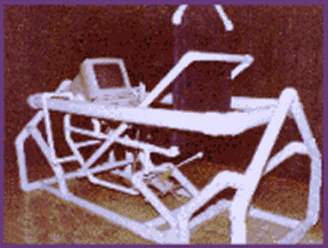Introduction
to the JoyRider
A
DO-IT-YOURSELF FLIGHT SIM MOTION PLATFORM
(or "How to make a joystick big enough to ride on!")
by Ken
Hill
As a private pilot, designer, and PC flight sim fanatic, when I first heard about a motion platform for home use, I was very excited. Until I saw the prices!
The "Fly It"  stripped base
model in the mid '90s started at $2000.
stripped base
model in the mid '90s started at $2000.
The most impressive I've seen, the "VACS"  tops $30,000!
tops $30,000!
My first hang-glider was only five
hundred dollars. Although not much more than a "kite" ![]() it at least
flew.
it at least
flew.
My next hang-glider cost
me a thousand dollars and was a "Stratos"  and it flew
quite well.
and it flew
quite well.
My first ultralight aircraft. an "Easy Riser"
 was only two thousand dollars and even though I had to
build it and teach myself to fly it, it did indeed fly (most of the time).
was only two thousand dollars and even though I had to
build it and teach myself to fly it, it did indeed fly (most of the time).
My next two thousand dollar flight investment was a
half interest in a run-out Aeronca Chief  which also
really flew.
which also
really flew.
With this in mind, I decided to try my hand at designing a do-it-yourself motion system that would not only get me "off the ground" but wouldn't cost me the down payment for my next plane. A few months of R and D, a few hundred dollars worth of off-the-shelf supplies, and a few days of assembly, and I was rocking and rolling big time!
The "JOYRIDER"s minimum flight design goals were as follows;
· REAL FEEL responsiveness and balance
· Maximum motion range (positive G's only for now)
· Progressive stick resistance and stability
· Simple low-tech mechanical control activation
· Smooth ball-bearing suspension
I'm happy to report that these goals have been successfully met.

Without the use of expensive hardware, I now have a VERY fast, smooth and exciting motion platform for my flight programs. Best of all I have it affordably constructed from readily available supplies with simple hand tools.
Here's the present specs;
· Full motion range, figure "8" stick stir - 2 SECONDS!
· Over 20 degrees of pitch and roll range.
· Hands off stability with one finger sensitivity.
· Weight range - fully tested with a 210 pound pilot.
As with all engineering, everything is a compromise. Design it too responsive and you reduce stability. Build in too much range and you reduce response. Too stable and you lose range; etc. etc. etc. forever.
Initial design configurations were tested with a CAD program in advance of actual construction, but many trial and error, seat of the pants refinements were needed toward the end to get that "Real Feel" I wanted. In fact, some tests became down-right dangerous before limits were set. When you have 200+ pounds of mass swinging at those speeds, the stability factor becomes very important, very fast! We actually crashed and burned a couple of variations that had stability levels ranging from neutral to negative.
With your favorite flight program loaded, the lights out, and the sound system cranked up, total immersion occurs. The stick input induced inertia can fool your inner ear into thinking that you are continuing to move in the direction you started even though you really don't. Instrument pilots know the feeling. What they see on their artificial horizon is not necessarily what they feel in their head. They have to trust their instruments or risk spinning in from following possible false sensations.
It was found that the added mass of the monitor greatly reduced the potential responsiveness of the platform. A projector or flat screen display will help reduce platform mass as well as greatly intensify the visual experience. When VR vision headsets become commonplace (and fast enough), this baby will be so 'simulating' that it's going to have to include a barf-bag!
Copyright © 1997 - 2023 Ken Hill - Springfield Oregon USA
NEXT - Chapter 1 - Design Your Own Motion Platform